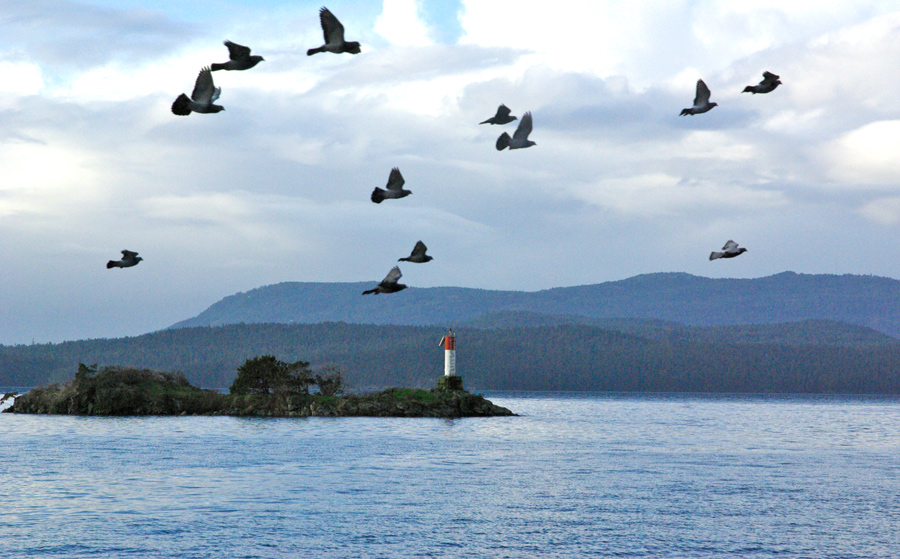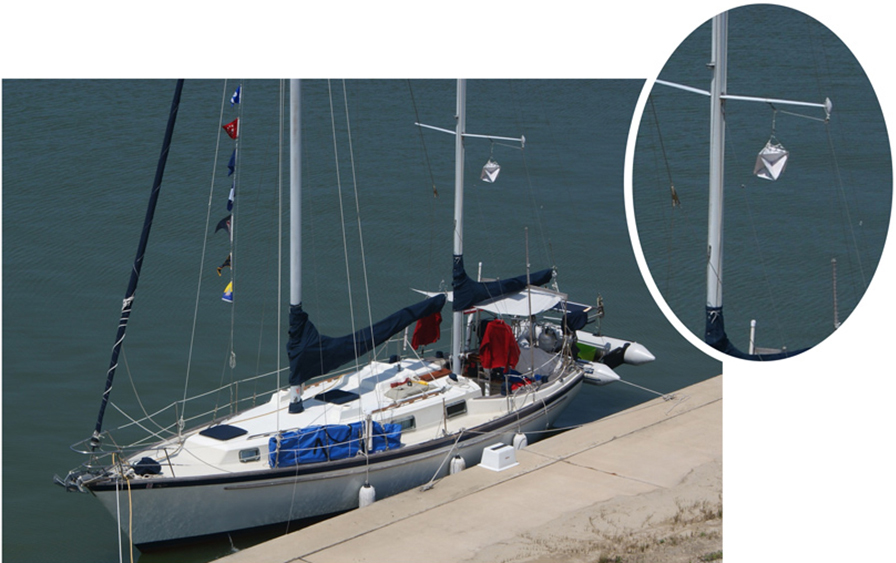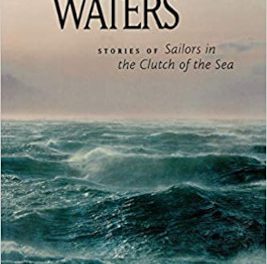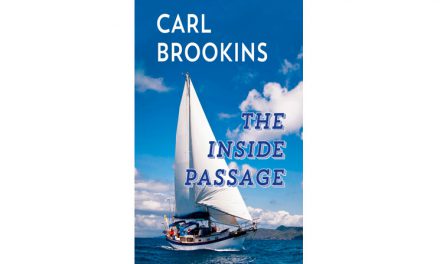
Paul Skene sent this photo of Boat Islet Light marking the entrance to Port Washington on North Pender Island, British Columbia. “I took this a couple years ago, on a visit to a dear departed friend, David MacKenzie, a master carpenter. I was in a de Havilland Beaver commercial float-plane from Vancouver, taxiing by this light heading for the town dock.” Send michael_r@goodoldboat.com your favorite hi-res photo of an aid to navigation, be creative. If we use your pic in Good Old Boat magazine, we’ll send you a Good Old Boat cap or shirt.
MYSTERY SOLVED
Nice and funny story (“The Mysterious Fish Magnet,” March 2018), but as a snorkeler and former wildlife management technician, I can say to Bob that his boat has no magnetic properties for fishes. Boats are like floating wharfs in that they offer fish a shadowed shelter. Fish hide there to snap any one of their smaller congeners. The darker and the bigger the boat, the better it is for them. In fact, the best way to grow a coastal fish population is to provide shelter, natural or artificial.
–Christian Nadeau, Verdun, Quebec
SAN FRANCISCO CAL
A brief “bravo” for your The Dogwatch piece on Cal 20s in that San Francisco Bay race. Half of my sailing fleet is a Cal 20, a sweet boat. I bought mine as a temporary boat, but promptly fell in love with her good manners and capable sailing. That’s why I’ve got two sailboats. Can’t part with either one. The other is a Seafarer Polaris that I’ve been sailing since 1968.
–Chris Campbell, Traverse City, Michigan
WHAT’S IN A NAME?
Just a quick correction to your Websightings column (“Feeling Serene?” Good Old Boat, March 2018). In Canada, it is only registered boats that must have unique names. Registration is required for all commercial boats, and recreational boats over a certain size/displacement. (A boat may optionally be registered, although I’m not sure why a person would go through the hassle and ongoing bureaucratic expense to register their boat only to end up with a name that has a number in it to keep the name unique, Mario 56 or Jennifer 87.) The names of licensed Canadian boats do not have to be unique, which is true for most every recreational boat. Licensing with the Canadian government is optional for all pleasure boats and required for pleasure boats with more than a 10 HP motor (unless the boat is registered). For licensed boats, the name is irrelevant, only the license number matters. I don’t know this, but I suspect you’re going to find much the same regulations for U.S. boats and that commercial U.S. vessels have a requirement for unique names as well.
–Alan Rothenbush, Vancouver, British Columbia
Thanks for the clarification Alan. It’s the same and different in the States. Like Canada, state-registered vessels can be named whatever the owner wishes, as the name is irrelevant (sounds like state registration in the US is akin to licensing in Canada). And Federally documented vessels (akin to Canadian-registered vessels) must be named, whether private or commercial. But unlike Canada, documented vessels do not have to have a unique name. My own boat, Del Viento, shares her name with both a recently scrapped 487-foot freighter and a 31-foot sailboat in Oceano, California. –Michael Robertson
BENT-NAIL TECHNOLOGY
 I read with great interest Dan Spurr’s article on repair of soggy balsa core under stanchion bases (“Building a Solid Base,” Good Old Boat, March 2018). My interest was high because over four decades of sailboat ownership I have performed many deck repairs on several boats where moisture had infiltrated the balsa coring of the deck.
I read with great interest Dan Spurr’s article on repair of soggy balsa core under stanchion bases (“Building a Solid Base,” Good Old Boat, March 2018). My interest was high because over four decades of sailboat ownership I have performed many deck repairs on several boats where moisture had infiltrated the balsa coring of the deck.
In making repairs like Dan’s repair of the stanchion bases on his Pearson 365, I created a very simple tool that removes much of the tedium from the work, as well as speeding up most similar projects. I call it “bent-nail technology.”
It’s simply a nail bent 90 degrees and inserted into a power drill. I inserted the nail through each existing bolt hole in the deck and then the powered up the drill. The rotating nail would loosen and chop-up the offending wet balsa, which I could then suck out through the bolt holes with a shop vac.
The length of the bent end of the nail can be varied depending on how much balsa needs to be removed from around each bolt hole. I never experienced any difficulty inserting the bent part of the nail into wet balsa. Using bent-nail technology often eliminated the need to remove fiberglass deck laminate as Dan did for his project.
Dan was fortunate that moisture around the bolt holes in his stanchion bases did not migrate far. He cited Everett Pearson’s experiment with a submerged balsa board and his conclusion that water does not migrate far through balsa coring. My experience challenges Pearson’s conclusion.
My 1974 Ranger 37 had a substantial section of the balsa-cored port-side deck that was saturated. Much of the wet core was feet from the point of water entry (electrolytic-corroded 5/16-inch stainless-steel bolts attaching a large aluminum chain plate cover).
I later owned a 30-foot racer/cruiser that was built in large numbers during the 1980’s. This boat’s balsa-cored hull was wet from stem to stern on the starboard bottom. Much of the wet balsa core was as much as ten feet from the nearest through-hull fitting. (The hull for this model was laid-up in two halves, possibly explaining the absence of migration of moisture to the port half.)
Subsequently, I owned another 30-foot racer/cruiser built in 1987, purchased when it was fourteen-years old. This was a custom build using epoxy and vacuum bagging. The balsa in the deck was bone dry when I bought the boat and it remained that way for another ten years. Along the way I installed a new depth transducer. At some point, the bedding compound around the transducer failed and admitted moisture into the balsa core. When I sold the boat, a moisture meter showed a high moisture content in the hull in about a nine-inch radius around the transducer.
Obviously, because my observations did not come from controlled experiments, I cannot definitively refute the industry lore that moisture does not migrate through balsa. On the other hand, if I accept that moisture does not migrate through balsa, I’m left to conclude that the water in my hulls and decks traveled between the core and the hull skins, and that these boats were therefore built with egregiously little adhesion of the core to the laminates. I think this would be a difficult argument to make, especially in the case of the boat with the vacuum bagged hull.
–Ed McKeever, Osprey, Florida
THE BIG REFLECTION
Last month I put it to the readers about radar reflectors. I wanted to get a sense of how dedicated people are to using them. I wanted to know if anyone had been able to compare signatures with and without a reflector (such as by being in communication with a radar-equipped vessel while raising and lowering a reflector). I wanted to know if anyone considered radar reflectors ineffective or not worth the time and hassle. –Eds.
I’ve had radar reflectors on every boat that I took through shipping lanes to Catalina Island from multiple Southern California harbors (though not on my last two boats, a Yankee Dolphin 24 and a Nonsuch 26).
I’ve no personally obtained evidence on whether they work, but Practical Sailor did articles about them in 1995, 2001 , and 2002 .
The gist of the 1995 article was that the inexpensive Davis Echomaster did as well as anything else, supporting the pro side. The gist of the later articles was that none of the tested reflectors did so well that you could win a negligence lawsuit against the boat that ran you down, supporting the con side.
For a long time, the cheap Davis seems like cheap insurance (and find me a sailor who hasn’t blown more on something). Today, AIS transceivers are available for those who want to see and be seen, AIS receivers for those who want to know where the other guy is, and inexpensive phone apps for those who want some protection for less cost.
The cheapest approach, which works well most of the time, is to put no faith in the other guy.
-Bob Neches, Los Angeles, California
We always have a Davis aluminum reflector hanging halfway up the backstay. It always got top honors from Practical Sailor. I am surprised your boat is visible without a reflector. I often encounter small boats that give no or poor radar return signals. I suppose large craft radars are improving. Offshore we run an AIS so we can see and be seen. Large ships regularly have changed course upon request when conditions make a course change inconvenient for us.
–Terry Thatcher, Adavida, Portland, Oregon
When on a cruise, I always have a metal Davis radar reflector suspended in the catch rain position from a spreader to get more effective height. To protect the sail cloth from chafing on the sharp edges, I cover them with an inch-wide band of duct tape (renewing the tape when wear shows).
I have some observations:
[a] Practical Sailor did exhaustive testing over a decade ago. I suggest that you look up their archives for hard data. Other types cost more and comparative reflective effectiveness varies from worse to better.
[b] Anecdotal datum: A friend, who worked on and commanded Algoma Great Lakes freighters for over thirty years, said that even a wet sail can help to reflect radar. He sailed blue water freighters too.
[c] My conclusion is that the more visible one is, the safer one potentially is.
[d] Of course, the radar reflector is only one low-tech tool to reduce the lemons popping up on the slot machine of life.
–Dave Toogood, Cadenza I (Alberg 29), Erieau, Ontario
Practical Sailor tested radar reflectors years ago and I believe the Davis folding type made of metal was the best if mounted in the “catch rain” position. Keeping it vertical makes quite a difference regarding effectiveness.
–Keith Elms, Libertyville, Illinois
I still have the RadarFlag I used for nearly 20 years on my old Tancook Whaler. This is an ingenious device which has aluminum thread woven into an American flag, and when hoisted on the back stay gave my 32-foot schooner the radar signature of a 250,000-ton tanker — or so I was informed by containership skippers by radio on the Chesapeake.
RadarFlags were manufactured and sold in the 1990s and were surprisingly reasonable. I recently tried to track down a larger one for my CS40 and found the company has vanished. Somebody find out what happened and bring it back!
-Ken Ringle, Washington, D.C.
 We made our radar reflector using information we found in Ferenc Maté’s The Finely Fitted Yacht. For material, I used an old aluminum sign. I assemble the reflector and use seizing wire to hold it together. We hoist it to the port mizzen spreader and tugs report that they get a good radar image, but I have never lowered it to get a report on how we look without it.
We made our radar reflector using information we found in Ferenc Maté’s The Finely Fitted Yacht. For material, I used an old aluminum sign. I assemble the reflector and use seizing wire to hold it together. We hoist it to the port mizzen spreader and tugs report that they get a good radar image, but I have never lowered it to get a report on how we look without it.
We feel safer with the reflector (and the boat looks naked without it swinging gently up there). After a pair of doves nested in our reflector, I rigged a small line to keep the birds away.
–Jim Shell, Texas Gulf Coast
Jim, love the Good Old Boat burgee visible in this photo!—Eds.
I have used a radar reflector for 38 years on my Hunter 27. I try to not sail in fog, but at times can get caught in it. About 5 years ago, motoring through a dense fog in Adolfus Reach (Lake Ontario), an over-40-foot power boat was bearing down on me, head on. Quick action by my crew avoided a collision. Either he was not looking at his radar or my reflector was not effective. I doubt it was my reflector.
Relying on a radar reflector to prevent collision means you are trusting the “other guy” to be vigilant and act. This is not a good practice. Good seamanship is always essential. I avoid sailing through “pea soup” if at all possible. A radar reflector adds a little more security, but in my opinion, only a little.
–Patrick Siconolfi, Rochester, New York
I use my Davis metal radar reflector—rigged in the proper position—when I go outside the bay. I’m thinking about buying a second one so I can double my visibility.
–Gregg Bruff, Arcturus, Lake Michigan
Radar reflectors are fine, but I’d encourage all your readers to get some kind of AIS system onboard as well. Not only will it tell the ships where you are and which way you are heading, but they can greatly help with a MOB recovery if combined with personal MOB transmitters on life vests. It is a great system.
–Ken Quant, Milwaukee, Wisconsin
We fly one of those cardboard/foil things when we go up the coast to San Francisco from Santa Cruz on our Santana 22. It makes us feel better, if nothing else. We have never radioed for a check on its effectiveness. On the other hand, we were delivering a Catalina 30 to San Diego for a regatta and the vessel had one of those tubular affairs up on the mast that looks like a long, thin fender. On our AIS we saw a ship that looked like it would pass close by. The skipper hailed the ship via AIS and they responded that we were a bright radar target and we should hold our course to pass safely. This was at night and we felt quite relieved.
–Stefan Berlinski, Hamachi, Santa Cruz, California
We’ve had a radar reflector mounted on the backstay about 8 feet up on both of our Islanders over the past 20+ years. Sailing on both the inside waters of the Salish Sea as well as the west coast of Vancouver Island, we are constantly exposed to large commercial vessels (including BC Ferries, the largest ferry fleet in the world) and smaller, high-speed commercial and pleasure boats. Fog in the spring and fall, particularly on the west coast, presents a danger.
Our reflector is all of 25 years old, the standard square-panel aluminum box (I don’t recall the name of the shape) mounted in a near “rain catcher” position. I have fellow sailors with radar and enquired with them on our electronic visibility. I have yet to find a boater who could not identify me at the maximum range of their set, usually about 10-12 miles in calm seas. I’ve also been on the bridge of a BC ferry and had a look at their much more sophisticated radar sets. I could identify small sailboats almost beyond visible range. The Canadian and American Coast Guard units operate shore-mounted radar covering all the coastal waters, particularly the Salish Sea, primarily to facilitate commercial traffic control. I was on a tour of the Vancouver facility 30+ years ago and, with the Cold War technology of the day and on a quiet nightshift, staff were casually betting on the number of railway cars on a causeway 20 miles away. They could see individual cars!
In properly trained hands, radar is a very powerful tool. But without regular use and practice (on a clear day!), the skill in using the tool is soon lost. In recent years several boating friends have purchased new equipment with radar overlays on chart plotters, an even more powerful tool. But the operator still needs to know how to operate and identify potential conflicts, and that isn’t always happening.
As a slow boat (6 knots under power) I sail with the reflector always in position and my AIS receiver linked to the chart plotter. That, along with the Mark I eyeball on a proper lookout, has kept me reasonably safe. Unfortunately, there isn’t much I can do about a high-speed powerboat running at 20+ knots in reduced visibility other than to stay in port. But then I can’t do much about the vehicle coming at me around the curve while the driver is distracted on a cell phone either. And there’s a lot more of them!
–Bert Vermeer, Natasha, Sidney, British Columbia
Sailing on Maine’s Penobscot Bay among the islands where lobster boats cruise at 20 knots in the fog, I’ve always thought it wise to have a radar reflector. I recently upgraded to the top-of-the-line canister type and feel very good about it. Also, with this model I’m able to leave it up all the time, which is a big plus, especially when sailing solo.
–Steve Ettlinger, Brooklyn, New York
Decades ago, I bought a Redwing 30 in Toronto and brought it through the Erie Canal, sailed the Hudson, and up the coast to the Fundy. I was concerned about sudden fogs in the Fundy, so I had bought a Davis “rain-catcher” aluminum reflector.
Approaching Grand Manan, I hoisted the reflector and called Fundy Control (they use radar to control maritime traffic in the area) and asked if they could spot me. I was reassured by their response: “What sort of vessel are you? Are you a freighter?”
–Paul Campbell, Halifax, New Brunswick
I recall (vaguely) an article I read on this subject many years ago. I think the conclusion was that the high-priced specialty reflectors didn’t do as well as the simple aluminum sheet units from Davis. I have one of these, with a harness I made to hang it in the catch-water configuration. Aboard our Mariner 28, I have only ever hoisted it in fog, which is to say, not often! I think that the bigger the unit, the more reflection it gives.
–David Salter, Day by Day, Lake Ontario
We sail Southern Belle, a good old Com-Pac 23, on Lake Michigan and have trailered to Bayfield and the North Channel several times. We always hoist our reflector when crossing the lake, which is usually at night and at other times of limited visibility. We have the Davis foil covered foam model, which I think I remember seeing as highly rated in a test probably decades old now. It rated as good as the aluminum model for effectiveness, but it is less durable. We take care of it when not hoisted by storing it carefully in it’s deployed configuration, not dis-assembled. When hoisted to the spreaders, we have it tied off to the upper shroud to prevent rotation. Once, sailing through Death’s Door north of Door County, Wisconsin, a ship contacted us to state his intentions heading out to the lake. It was at night amd we heard from him before even seeing his lights, so I’m sure he didn’t see ours. Must have been the reflector that made us visible to him. I recommend it; can’t have too much safety gear!
–Rick Pask, Hortonville, Wisconsin
Many years ago (early 70’s) my wife and I were sailing our Shark back from Toronto in the fog. We would cross or merge with four freighter traffic lanes in and out of Hamilton Harbour on Lake Ontario. We could hear the low rumble of the laker’s engines. Not being able to identify the direction of the sound, we raised our aluminum radar reflector. Less than a minute later (must have been on the next sweep), we heard the freighter’s horn loud and clear and knew exactly where she was in relation to our small boat.
Our current boat is a C&C Corvette on which we have a tubular radar reflector permanently mounted on the backstay.
–Leo Reise, Windflower, Mount Hope, Ontario
We always use a radar reflector. The proper Davis aluminum model, in the rain catcher position, just below the spreader, fog or no fog. Also, I think the radar reflector might bounce signals a longer distance than the nav lights shine at night. I’m not certain, but belts and braces….
–R. Todd Smith, Wareham, Massachusetts
I sail the Puget Sound area and I use a reflector, but I am not at all confident the commercial ships going 16 knots in the separation lanes can distinguish me from the clutter. We can call the Puget Sound Vessel Traffic Service (VTS) and find out what vessels are near us and let them know when we’re crossing traffic lanes. I think AIS, with a transponder that pings your location, is the way of the future as costs come down.
–Walt Elliott, Kingston, Washington
I have a Davis metal radar reflector on my 26-foot Nonsuch.
Transport Canada requires a radar reflector on: “boats under 65 feet 7 inches (20 meters) in length and boats that are built of mostly no-metallic materials.” But Transport Canada makes exception for vessels that operate strictly, “in limited traffic conditions, daylight, and favourable environmental conditions, and where having a radar reflector is not essential to the boat safety.” Additionally, if a boat only operates away from radar navigation and its small size “makes having a radar reflector impractical,” then it is also not required. For more info, see page 28 of the “Safe Boating Guide” produced by Transport Canada and available at www.boatingsafety.gc.ca.
–Mark Powers, Surrey, British Columbia




